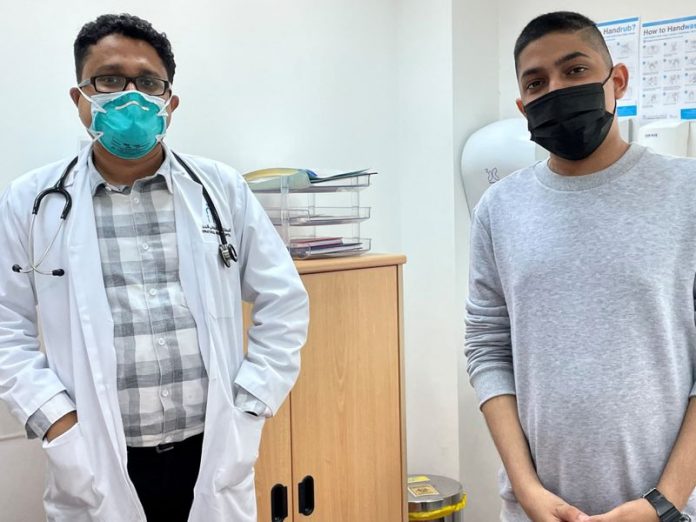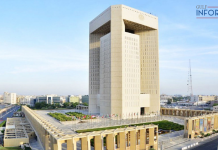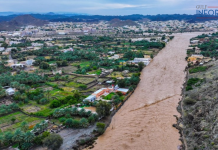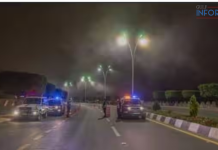
Miracle in Dubai: In a miraculous feat involving a multidisciplinary team of doctors at the International Modern Hospital, a 17-year-old asthmatic boy was literally pulled out of the jaws of death. He not only suffered acute respiratory distress and was deprived of oxygen, but also suffered three cardiac arrests. However, quick and efficient teamwork from the doctors helped save the life of the young boy who has completely recovered since then.
‘Help I cannot breathe!’
Keanne Alston, a 17-year-old high school student, made an emergency call to Dubai Corporation for Ambulance Services (DCAS) when he sensed the onset of an asthma attack.
Recounting the incident, his mother, Suzi Alston, a widow working for a corporate group in Dubai, told Gulf News: “Keanne used to study in Dubai earlier, but being single and working, I decided that he move to be with my family and live with his cousins and grandparents back home in India. He was visiting me in Dubai, but was stuck during the lockdown. On that day he sffered the attack, I was away at work when he called me, saying he was finding it difficult to breathe. I immeddiately advised him to call the ambulance, even as I rushed home.”
Patient collapses
In the meanwhile, the respiratory distress got so bad that Keanne collapsed and stopped breathing, even before he could tell the paramedics his location. Quick-thinking paramedics, with no clue regarding the whereabouts of the patient, still managed to locate his apartment using GPS tracking of the call within seven minutes and found him blue and unable to breathe. They quickly provided him with first aid, revived basic breathing manually and rushed the unconscious patient to the Emergency Room (ER) of International Modern Hospital. By then, the paramedics has started manual ventilation for revival.
Dr Mohammad Aslam, specialist pulmonologist at the IM Hospital, told Gulf News: “This was a rare case. The patient had not been on any medication. He suffered from many allergies and no one knows what triggered the respiratory distress. The ambulance paramedics put him on mechanical or ambu ventilation. This involves a mask with one end attached to a balloon-like device that is blown and compressed mechanically by the paramedic to force air into the lungs. This could work only for a short period. Luckily, by then, the patient was in the care of our ER doctors.”
After that, the entire medical team at IMH worked around the clock to ensure this battle between life and death was won. “As a pulmonologist, this was one of the toughest cases I have handled in my career”, recalled Dr Aslam.
Body turns blue
Since the patient had a respiratory arrest and went unconscious before reaching the hospital, the body was bluish. Intensivist and specialist in critical care, Dr Nitin Tarale, intubated Keanne in the Emergency Department with anaesthesia medication, as the airway was very tight to pass the endotracheal tube. After Keanne was stabilised from the Emergency Department, he was moved to the Intensive Care Unit (ICU) and connected to a mechanical ventilator.
However, the young boy was in for more trauma. Further evaluation indicated that Keanne’s chest tightness was not relieved even with ventilator support and medication. “We tried all the available medication in our hospital and also arranged medicines from outside. A CT SCAN of the chest was performed, which showed that blood supply to some parts of the lungs was blocked and we started medication for that. Still his condition continued to be critical”, recalled Dr Saad Abbas, consultant — Critical Care Medicine.
Three cardiac arrests
On the fourth day, on January 24, the condition of the young boy got worse and while still in the ICU, he suffered a cardiorespiratory arrest. The patient was administered cardiopulmonary resuscitation (CPR) three times as per ACLS (Advanced Cardiovascular Life Support) protocol and the heart started to beat again, but the lungs were still very weak.
Dr Siva Malikireddy, specialist general surgeon, added: “Further evaluation after resuscitation identified that there was an air leak in the right lung and I immediately did a chest tube insertion.”
Medical experts at the hospital also discussed the case with external experts and were advised to continue the same treatment without much expectation.
Finally out of the woods
Following all the medical protocol for the next two weeks, the doctors were able to stablise the patient who was then weaned off the mechanical ventilator, his chest was cleared and he was able to continue breathing independently. Keanne was finally discharged and has since recovered completely. Dr Aslam said: “We have put him on complete asthma medication and provided the inhalation pump so that he does not suffer such an episode again. He is coming to the hospital for weekly follow-ups and doing quite well.”
Mother thanks doctors
Keanne’s mother added: “I had no idea that I was living so close to such a good hospital. The team really valued the life of my son and worked round the clock to save him. He is doing very well now and will return to India shortly. It was nothing short of a miracle and I would like to thank the entire team at the hospital and all others in nursing my son back to good health.”
How paramedics revive patients
When a patient is unable to breathe independently, it is vital to induce breathing so that the brain cells are not starved of oxygen.
Ambulances are equipped with a bag valve mask (BVM), which is also called an ambu bag. This is a handheld tool that is used to deliver positive pressure ventilation to any subject with insufficient or ineffective breaths. It consists of a self-inflating bag, one-way valve, mask and an oxygen reservoir.
The mask is manually held against the face. The self-inflating bag (resuscitator bag) is attached to a non-rebreathing valve and then to a face mask that conforms to the soft tissues of the face. The opposite end of the bag is attached to an oxygen source (100 per cent oxygen) and usually a reservoir bag. The mask is manually held tightly against the face and squeezing the bag ventilates the patient through the nose and mouth. This can be done for a limited period of time to maintain airflow to the lungs and out until the patient can reach an ER and be intubated and transferred to a mechanical ventilator.
Ambu bag is an emergency life-saving equipment used in most ambulances in Dubai to manually resuscitate a patient who may have collapsed and is incapable of independent breathing.



